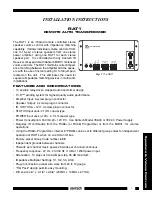
AIMA3000.FT5P Product User Manual
Technetix Group Limited
•
technetix.com
May/2016 - Version 1.0
48
7 Troubleshooting
Indicator for determining faults
If there is a fault, the operator can use the status LEDs to determine the location and condition of the fault. Please see
Table 7-1
below:
Table 7-1 Fault Judgment Table
Alarm Indicator status
Common Faults
Trouble Shooting
LSR1/LSR2/LSR3/LSR4 is Amber
Laser Temperature is higher(Hi) or lower(Lo).
Check the laser’s temperature.
If the temperature is normal, please
contact Technetix technical support.
Laser Case Temperature is higher(Hi) or
lower(Lo).
Check the Laser Case temperature.
If the temperature is normal, please
contact Technetix technical support.
Laser Bias Current is higher(Hi) or lower(Lo).
Check the laser’s Bias Current.
If the Bias Current is normal, please
contact Technetix technical support.
Laser Output Power is higher(Hi) or lower(Lo).
Check the laser’s Output Power.
If the Output Power is normal, please
contact Technetix technical support.
Laser is shutdown.(“Laser Output Status Alarm
”is set “enable Minor”)
Turn on the laser.
RF Input Power is higher(Hi) or lower(Lo).
Adjust RF input signal.
LSR1/LSR2/LSR3/LSR4 is red
Laser Temperature is too high (HiHi) or too low
(LoLo).
Check the laser’s temperature.
If the temperature is normal, please
contact Technetix technical support.
Laser Case Temperature is too high (HiHi) or
too low(LoLo).
Check the Laser Case temperature.
If the temperature is normal, please
contact Technetix technical support.
Laser Bias Current is too high(HiHi) or too
low(LoLo).
Check the laser’s Bias Current.
If the Bias Current is normal, please
contact Technetix technical support.
Laser Output Power is too high(HiHi) or too
low(LoLo).
Check the laser’s Output Power.
If the Output Power is normal, please
contact Technetix technical support.
Laser is shutdown.(“Enable Major)
Turn on the laser.
RF Input Power is too high(HiHi) or too
low(LoLo).
Adjust RF input signal.




































